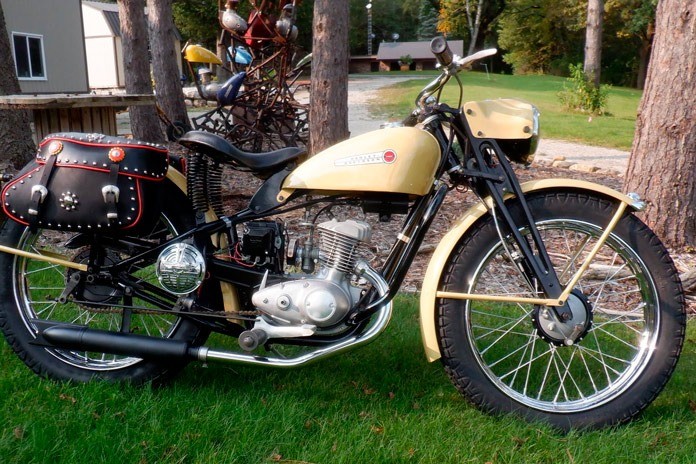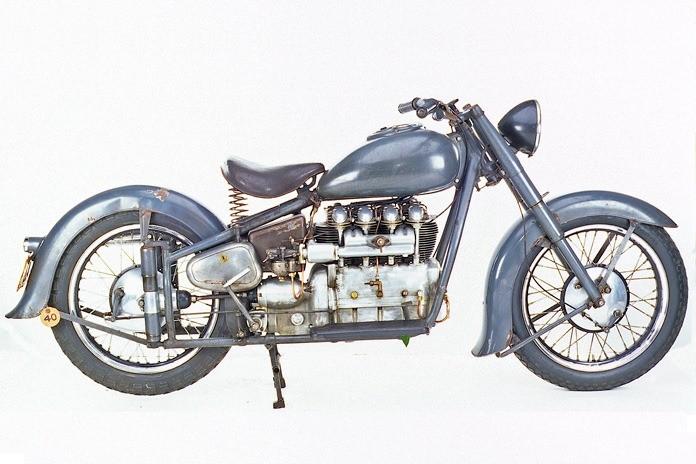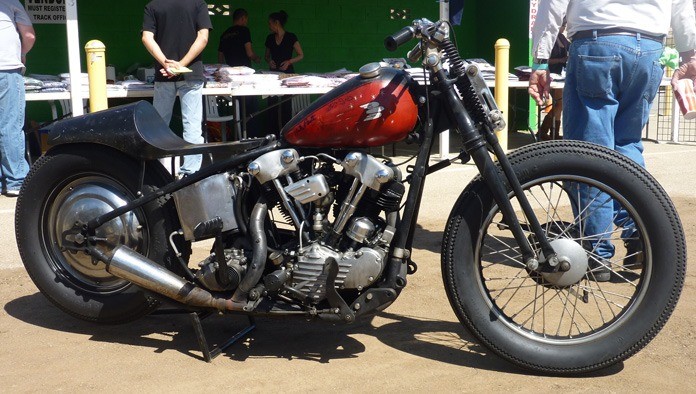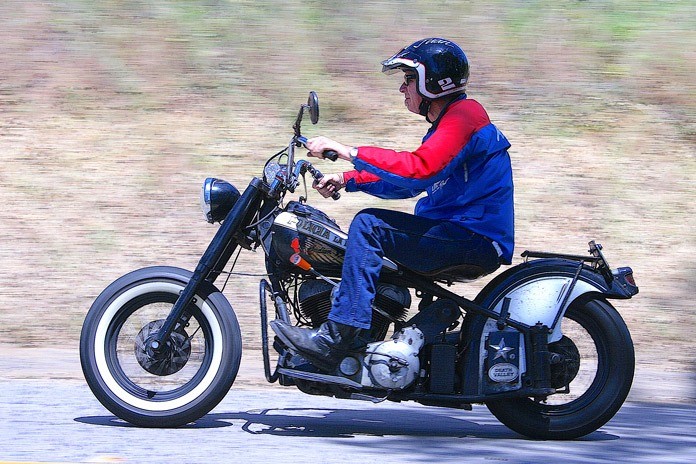 Source: American Rider –
Source: American Rider –
Below is the third installment of our Harley-Davidson vs Indian Motorcycle series, which explores the historic rivalry between the two giants of American motorcycling. This installment covers the years after WWII until Indian closed its doors in 1953 and was originally published in American Rider’s November 2023 issue.
Related: Harley-Davidson vs Indian Motorcycle Part 1
Related: Harley-Davidson vs Indian Motorcycle Part 2
Following the second World War, the United States was essentially the “last man standing.” Our country was relatively untouched by war, and our prodigious manufacturing abilities were obvious to vanquished enemies and exhausted allies alike.
We were in the odd position of assisting both the beaten and beat up, but our economy rebounded exponentially while other nations rebuilt slowly, which helped make us the richest and most influential nation on Earth. But not all U.S. companies prospered, especially those in our motorcycle industry.

Harley-Davidson’s total sales for the first full year of peacetime, including the little 125cc design it got as war reparations from DKW in Germany, dropped to 16,122. Aside from an official “thank you” from the U.S. government, that was it. At least Harley-Davidson had money in the bank and plans for the future.
Indian Retools
Things were less rosy at Indian. The bike it made for the war, the 841, was deemed too expensive to produce for a civilian market, and production of the Scout ceased. The Chief was the only Indian V-Twin that remained in production. Some dealers were so upset about the Scout being dropped from the lineup that they invaded factory board meetings in a rage.

Indian’s leader, Paul duPont, didn’t realize until it was too late that his company was becoming the victim of a hostile takeover. He wasn’t in good health, and after 15 years of keeping the company alive for minimal profits, he turned over Indian’s operations to a group led by Ralph B. Rogers in November 1945.

Rogers moved manufacturing out of the antiquated Wigwam and into a smaller factory, and Indian got its own 125cc war reparation: a copy of a CZ designed in Czechoslovakia. Also filling a lineup hole was a rebadged Corgi Scooter called the Papoose.
The new regime had good intentions, and Indian had a new lightweight product line in the prototype stage. It was a modular group comprising a 10.5ci (172cc) OHV Single, a 21ci (344cc) OHV parallel-Twin, and a 42ci (688cc) OHV 4-cylinder to be called the Torque Four.
With the Chief paying the bills for 1947-48 (now with the famous Indian “war bonnet” on the front fender) and the 125cc bike a sales bust, Indian revised its plan. The new engines got bigger – to 13, 26, and 52 cubic inches, respectively. The model codes of “149” for the Single and “249” for the Twin indicated production for the 1949 model year.

Sure enough, the Arrow and the (new) Scout went into production on July 15, 1948. However, they often suffered breakdowns and turned out to be disasters. Out of necessity, the Twin was improved and enlarged to 500cc and rechristened as the Warrior. Sadly, the Four was scrapped. Meanwhile, the Chief received a telescopic fork for the 1950 model year.
Around the same time, Rogers stepped away from Indian for a job at Texas Instruments. His replacement was John Brockhouse from Brockhouse Engineering, which had produced the Papoose for Indian.
In Milwaukee, Harley-Davidson introduced the Panhead in 1948. H-D had learned a lot from WWII developments, especially about aluminum cylinder heads, so the Knucklehead’s replacement had them. The EL used a 61ci engine, while the FLs had a 74ci motor. Coupled with maintenance-free hydraulic lifters, the Panhead was a big step forward in technology, and the platform was upgraded with a telescopic fork in 1949 to become the Hydra Glide.

In 1952, Harley-Davidson debuted the new K-model, which was powered by a 750cc (45ci) side-valve V-Twin. With the Scout no longer in production, the MoCo had that market to itself, at least until the trickle of British Twins grew into a flood. When the Triumph Thunderbird was featured in the seminal film The Wild One in 1953, it kickstarted the birth of a new feud.
Racing Rivalry
In the midst of all its upheaval, Indian managed to build 50 “Big Base” Scouts and get them into the right hands for racing. This last “real” Scout, the 648, scored a win at Daytona in 1947 in the hands of Johnny Spiegelhoff and again in 1948 piloted by Floyd Emde.
Class C racing was a different ballgame by the late 1940s, becoming a sort of “C-plus” class. Harley-Davidson and Indian both had full-blown racing versions of the bread-and-butter bikes the class was supposedly based on. At the grassroots level, there were regular riders who wanted to go out and “see what she’ll do,” making for cheap and frequent fun at the track.

The next level up was the serious and sometimes gifted amateurs. These guys knew about the hop-up parts the factories had and figured out ways to get them, usually through like-minded dealers. Some rode well enough to be sponsored.
The top tier showcased the factory-sponsored racers favored to win nationals. Sophisticated rule bending became the “hush-hush” norm. Indians used Harley parts and vice-versa – whatever it took to win. Full-on “cheaters” like the “Chout,” which combined Chief and Scout components to make a machine that would outrun either of the originals, were easy to single out and wouldn’t be tolerated at the track. On the street – well, why not?
The MoCo made efforts to improve the W-series bikes, especially the WR racebike that featured alloy heads. The general consensus, born out by race results, was that the Scouts were faster in short races, but long races belonged to the hard-to-kill WR.
Racers have a code: When the green flag drops, the BS stops. It’s every man for himself during the race, but afterward it was beer, conversation, and congratulations. Any serious battles were usually fought among the spectators when fans wearing their favorite brands on shirts and hats got to the beer early and rowdy behavior ensued.
A lot of the scuttlebutt that informed notions of Harley vs. Indian wars came from stories about guys like Rollie Free and Max Bubeck.

Free began as perhaps the best street racer ever. In 1923, he bought a Harley racebike that lacked the performance he’d been promised. His complaints fell on deaf ears, and from then on, he regularly tried to outrun any machine from Milwaukee on any other brand he could ride.
Bubeck was an Indian fan to the core and showed a natural prowess in enduros. He frequently won, most famously on a big Indian Four. “I didn’t know it couldn’t be done,” he said after a win, “so I did it.”
Related: Riding the Max Bubeck Indian Four
Both men were a little chapped at H-D’s speed record from 1936, and both tried to break it. Bubeck built the ultimate Chout with a Scout 101 frame and went 135.58 mph in June 1948 on Rosamond Dry Lake. It wasn’t quite enough to beat the Knuck, but it remains the record for an unstreamlined Indian. Bubeck was also a guy who could go fast on the new Warrior, winning the Cactus Derby desert race in 1950.

Free’s pursuit of speed culminated in switching to a foreign brand: Vincent HRD. In 1948 on the Bonneville Salt Flats, he went to the extreme of laying prone in his bathing suit on a Black Lightning. He achieved an incredible 150.3 mph, and a picture of his run remains the most famous photo in motorcycling.
There were plenty of guys like this on the Harley wagon as well, notably Tom Sifton, Jimmy Chan, and Larry Hedrick.
End of an era
The last of the pioneering men who had gotten American motorcycling this far, Arthur Davidson and Oscar Hedstrom, must have looked at the post-war situation with amazement. Both men had seen the creation of an industry, two World Wars, the Great Depression, backroom wrangling, the dominance of the automobile, and incredible speed contests of all kinds. It had been a nearly unbelievable experience but from two different perspectives.

Arthur Davidson was hands-on from day one at the company he co-created, watching it grow and mature up close. He was involved in every aspect of American motorcycling until he died in a car crash on Dec. 30, 1950, at the age of 69.
Around the same time, Indian was in turmoil. Rogers had borrowed money and made alliances to keep going. When the money ran out, the supposed allies closed in. Indian began to wind down production in 1952, and all manufacturing ended in 1953, the last year the venerable Chief was produced.

Indian’s Hedstrom had become a country gentleman, observing the industry from a distance until his death on Aug. 29, 1960, at the ripe old age of 89. He must have been intrigued during the days of the British motorcycle invasion, curious about the technical advances and the twists and turns in the industry, but surely disappointed by the woes that befell the historic company he founded. More than 50 years passed before new Indians capable of upholding the marque’s illustrious lineage were manufactured.
The post Harley-Davidson vs Indian Motorcycle Part 3 appeared first on American Rider.




